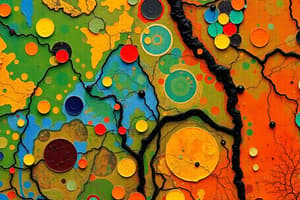Podcast
Questions and Answers
What is the primary purpose of the Dissolve operation in geoprocessing?
What is the primary purpose of the Dissolve operation in geoprocessing?
- To combine features from two layers
- To aggregate features based on specified attributes (correct)
- To modify attributes without changing geometry
- To create a zone around a spatial feature
Merge operations will always retain all original attributes from the input layers.
Merge operations will always retain all original attributes from the input layers.
False (B)
What is the result of the Buffer operation?
What is the result of the Buffer operation?
Produces a polygon layer around a spatial feature
In geoprocessing, the ______ operation combines features from two or more layers into a single layer.
In geoprocessing, the ______ operation combines features from two or more layers into a single layer.
Match the following geoprocessing operations with their descriptions:
Match the following geoprocessing operations with their descriptions:
Which of the following statements best describes the difference between overlay operations and other operations?
Which of the following statements best describes the difference between overlay operations and other operations?
Geoprocessing operations do not require consideration of geometry or attributes.
Geoprocessing operations do not require consideration of geometry or attributes.
What must be done when geometry modifications like clip or erase are performed?
What must be done when geometry modifications like clip or erase are performed?
What is the main purpose of the Clip operation in geoprocessing?
What is the main purpose of the Clip operation in geoprocessing?
The Union operation in geoprocessing only retains attributes from one input layer.
The Union operation in geoprocessing only retains attributes from one input layer.
What are the main types of geoprocessing operations mentioned?
What are the main types of geoprocessing operations mentioned?
The _______ operation removes part of the first input layer that overlaps with the second input layer.
The _______ operation removes part of the first input layer that overlaps with the second input layer.
Match the following geoprocessing operations with their functions:
Match the following geoprocessing operations with their functions:
What happens to attributes during the interect operation?
What happens to attributes during the interect operation?
Geoprocessing operations do not modify geometry but may change attributes.
Geoprocessing operations do not modify geometry but may change attributes.
In the context of geoprocessing, what must be considered regarding the output after operations?
In the context of geoprocessing, what must be considered regarding the output after operations?
Flashcards
Geoprocessing
Geoprocessing
Transforming spatial objects (like features on a map) into new or modified ones, changing both attributes and geometry.
Clip (Geoprocessing)
Clip (Geoprocessing)
Cuts a portion of a map layer using another layer as a 'cookie cutter'. Keeps only the part inside the clipping layer.
Erase (Geoprocessing)
Erase (Geoprocessing)
Removes the part of a layer that overlaps with another layer. Keeps only the part outside the erasing layer.
Union (Geoprocessing)
Union (Geoprocessing)
Signup and view all the flashcards
Intersect (Geoprocessing)
Intersect (Geoprocessing)
Signup and view all the flashcards
Identity (Geoprocessing)
Identity (Geoprocessing)
Signup and view all the flashcards
Overlay Operations
Overlay Operations
Signup and view all the flashcards
Key Questions for Geoprocessing
Key Questions for Geoprocessing
Signup and view all the flashcards
Other Geoprocessing Operations
Other Geoprocessing Operations
Signup and view all the flashcards
Merge
Merge
Signup and view all the flashcards
Dissolve
Dissolve
Signup and view all the flashcards
Buffer
Buffer
Signup and view all the flashcards
What is the purpose of overlay operations?
What is the purpose of overlay operations?
Signup and view all the flashcards
How do other geoprocessing operations differ from overlay operations?
How do other geoprocessing operations differ from overlay operations?
Signup and view all the flashcards
What are the key considerations for area calculations after geoprocessing?
What are the key considerations for area calculations after geoprocessing?
Signup and view all the flashcards
Study Notes
Geoprocessing Overview
- Geoprocessing transforms spatial objects, altering both geometry and attributes.
- Unlike spatial queries, it modifies spatial objects.
- Common modifications include creating/deleting features, altering size/shape, and physical cutting.
Key Questions for Geoprocessing Operations
- Does the operation change the geometry?
- Does the operation change the attributes?
- What is retained versus discarded in the process?
Types of Geoprocessing Operations
Overlay Operations
- These operations involve placing multiple spatial layers on top of one another to identify spatial relationships and extract new information.
- Requires at least two layers.
Clip
- Cuts a portion of the first input layer based on the shape of the second input layer ("cookie cutter").
- Resulting features retain the geometry within the clip boundary.
- Output attributes match input layer attributes without attributes from the clip layer.
- Example: Reducing a larger area to an area defined by another layer.
Erase
- Removes portions of the first input layer that overlap with the second input layer boundary.
- Remaining features have geometry outside the erase layer boundary.
- Output attributes match input layer attributes without attributes from the erase layer.
Union
- Combines overlapping and non-overlapping areas from multiple layers, creating polygons reflecting all combinations.
- Duplicates attributes in overlapping areas, potentially causing double-counting of features.
Intersect
- Retains only the areas common to all input layers.
- Output can be polygons, lines, or points, depending on input layers.
- Retains attributes from all input layers.
Identity
- Combines input layer geometry with attributes from an identity layer while preserving all input layer features.
- Maintains input layer geometry.
- Adds attributes from the identity layer in overlapping areas; assigns null values elsewhere.
Other Geoprocessing Operations
Merge
- Combines features from two or more input layers into a single layer.
- Attributes may be summarized or preserved depending on user specifications.
Dissolve
- Aggregates features based on specified attributes, resulting in larger features from smaller ones.
- Reduces the number of features (e.g., merging counties based on attributes).
- Summarizes attributes based on the aggregation process.
Buffer
- Creates a zone of specified width around a spatial feature (point, line, polygon).
- Output is a polygon layer, regardless of the input type.
- Can dissolve overlapping buffers to prevent double-counting.
Critical Questions for Geoprocessing Operations
- Is the geometry modified, and how?
- How many features are created or remain?
- Which attributes are included in the output?
Practical Considerations
- Area Calculations
- Careful handling of overlaps in buffers/unions to avoid overestimation if not dissolved
- Choosing the right tool (specific to goal)
Summary
- Geoprocessing is fundamental to spatial analysis in GIS.
- Overlays analyze spatial relationships (e.g., clip, erase, union).
- Other operations (e.g., merge, dissolve, buffer) modify geometry and attributes.
- Precise understanding of how these operations modify data leads to accurate spatial analyses.
Studying That Suits You
Use AI to generate personalized quizzes and flashcards to suit your learning preferences.
Related Documents
Description
Explore the fundamentals of geoprocessing, which involves transforming spatial objects by modifying their geometry and attributes. This quiz covers key questions, types of operations including overlay operations, and specific techniques like clipping. Test your understanding of how these processes alter spatial data.


